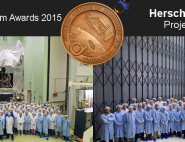Fledgling stars flicker in the heart of Orion
Astronomers using ESA's Herschel and NASA's Spitzer space telescopes have detected surprisingly rapid changes in the brightness of embryonic stars within the well-known Orion Nebula.
The nebula contains the nearest site of massive star formation, with intense ultraviolet light from hot young stars causing gas and dust in the region to glow.
Inside that dust - hidden at visible wavelengths - is a host of even younger stars, still growing in their earliest phase of evolution.
This new combined far- and mid-infrared image cuts through the obscuring dust and reveals these embryonic stars.
![]()
This new view of the Orion Nebula shows embryonic stars within extensive gas and dust clouds. Combining far-infrared observations from the Herschel Space Observatory and mid-infrared observations from NASA's Spitzer Space Telescope, the image shows newly forming stars surrounded by remnant gas and dust in the form of discs and larger envelopes.
Credits: ESA/PACS/NASA/JPL-Caltech/IRAM
Read the article on ESA's website


